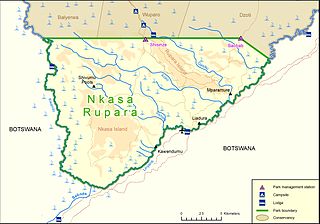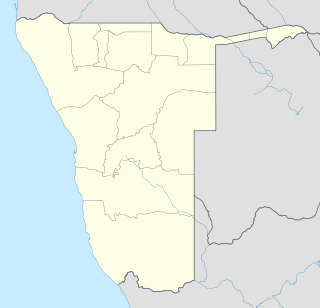Related Research Articles

The Zambezi Region, until 2013 known as the Caprivi Region, is one of the 14 regions of Namibia, located in the extreme north-east of the country. It is largely concurrent with the Caprivi Strip and takes its name from the Zambezi River that runs along its border. Katima Mulilo is its capital and the largest city, the Governor is Lawrence Sampofu. The self-governed village Bukalo belongs to this region.

The Caprivi Strip, also known simply as Caprivi, is a geographic salient protruding from the north-eastern corner of Namibia. It is surrounded by Botswana to the south and Angola and Zambia to the north. Namibia, Botswana and Zambia meet at a single point at the eastern tip of the Strip, which also comes within 150 m of Zimbabwe. Botswana and Zambia shares a 150 meters border at the crossing of Kazungula. The territory was acquired by the then German South West Africa in order to provide access to the Zambezi River and consequently a route to the east coast of the continent and German East Africa. The route was later found not to be navigable because about 40 miles east of the Caprivi Strip is Victoria Falls, the world's largest waterfall.

The Cuando River is a river in south-central Africa flowing through Angola and Namibia's Caprivi Strip and into the Linyanti Swamp on the northern border of Botswana. Below the swamp, the river is called the Linyanti River and, farther east, the Chobe River, before it flows into the Zambezi River.

Katima Mulilo or simply Katima is the capital of the Zambezi Region in Namibia. It is located in the Caprivi Strip. It had 28,362 inhabitants in 2010, and comprises two electoral constituencies, Katima Mulilo Rural and Katima Mulilo Urban. It is located on the national road B8 on the banks of the Zambezi River in lush riverine vegetation with tropical birds and monkeys. The town receives an annual average rainfall of 654 millimetres (25.7 in).

Lozi people, or Barotse, are a southern African Bantu speaking ethnic group who speak Lozi or Silozi a Sotho-Tswana language. The Lozi people consist of more than 46 different ethnic groups and are primarily situated in western Zambia, inhabiting the region of Barotseland.

The Caprivi conflict was an armed conflict between the Namibian government and the Caprivi Liberation Army, a rebel group that waged a brief insurrection in 1999 for the secession of the Caprivi Strip.

Albert Mishake Muyongo is a Namibian politician and former Member of Parliament who is currently living in exile in Denmark.

The MaYeyi are Bantu-speaking people of north-western Botswana and north-eastern Namibia. The Yeyi immigrated to the area in the 18th century from the north, and lived in close cooperation with the San people, or Basarwa, who had lived in the area previously. They speak ShiYeyi, a language that was influenced by the San and exhibits the characteristic clicks.
Victor Simunja is a Namibian politician. A member of the South West Africa People's Organization (SWAPO), Simunja was appointed to the National Assembly of Namibia in 2000 and served as Deputy Minister of Defense from 2000 to 2009. Simunja rose to the rank of Lieutenant Colonel in the Namibian Defence Force prior to entering political office. He is a member of the Mafwe ethnic group, indigenous to the Caprivi Strip.
The Caprivi treason trial is a trial in which the Government of Namibia indicted 132 people for allegedly participating in the Caprivi conflict on the side of the Caprivi Liberation Army during a period between 1992 and 2002. They were charged with high treason, murder, sedition, and many other offences, altogether 278 counts of criminal conduct.
The Subiya call themselves Veekuhane and their language is called Chiikuhane. Chiikuhane or Subiya language is classified under Zone K.40 of Bantu languages; a language of northern Botswana, Caprivi Strip, Namibia and Western Zambia up to Victoria Falls .Baumbach (1997:337) classified it as a "Zone k42 Bantu language". Torrend (1931), Shamukuni (1972), and Colson (1996) classified Chiikuhane language under the Bantu Botatwe group; indicating that the language is related to Western Tonga in Zambia and one of the earliest languages of the Zambezi believed to have arrived around Iron Age era. Bantu Botatwe share the distinctive root – tatwe for three. They include Subiya, Tonga, Toka, Leya, Fwe, Twa, Shanjo, Totela, Ila and Lenje. In the Caprivi, Subiya has been classified together with Fwe, Totela and Mbalangwe as one group of languages. Subiya language has a complete grammar book and a textbook containing folklore, superstitions and songs written in French and Subiya in 1896 and 1899 respectively, by the French Missionary Edouard Jacottet. Subiya language also has a complete grammatical sketch written in English and Subiya in the 1960s by Daniel Matengu Shamukuni.
Richard Kapelwa Kabajani was a Namibian activist, militant, diplomat and politician. Kabajani was a military commander for SWAPO during the Namibian War of Independence and after independence served a minister in the Namibian government.
Simataa Secondary School is a school in the Caprivi Region of Namibia. It is situated near the headquarters of the Mafwe traditional authority in Chinchimane, some 70 km south of Katima Mulilo. Patron of the school is Deputy Minister of Information and Communication Technology, Stanley Simataa.

Bwabwata National Park is a protected area in northeastern Namibia that was established in 2007 and covers 6,274 km2 (2,422 sq mi). It was created by merging Caprivi Game Park and Mahango Game Reserve. It is situated in the Zambezi and Kavango East regions, extending along the Caprivi Strip. It is bounded by the Okavango River to the west and the Kwando River to the east. Angola lies to the north and Botswana to the south.

Chinchimane is a settlement in Namibia's Caprivi Strip. It is situated approximately 70 kilometres (43 mi) southwest of the regional capital Katima Mulilo. Chinchimane belongs to the Sibbinda Constituency in Namibia's Zambezi Region.
The Masubia are a tribe in Caprivi Strip whose traditional authority (ikuta) is based in Bukalo.

Nkasa Rupara National Park, also Nkasa Lupala National Park, formerly Mamili National Park, is a national park in Namibia. It is centered on the Nkasa and Rupara islands on the Kwando/Linyanti River in the south-western corner of East Caprivi. Botswana lies to the west, south and east, and Sangwali village to the north. It is Namibia's largest formally protected wetland area. It is one of Namibia’s protected areas that benefits local communities surrounding parks. The unfenced park forms a trans-boundary link for wildlife migration between Angola, Botswana, Namibia and Zambia. Nkasa Rupara is part of the Kavango Zambezi Transfrontier Conservation Area.
The Vambunda are a Bantu people who, during the Bantu migrations, came from the north to south-eastern Angola and finally Barotseland, now part of Zambia. Their core is at present found in the south-east of Angola from the Lunguevungu river in Moxico to the Cuando Cubango Province.

Sangwali is a settlement in Namibia's Caprivi Strip, situated 130 kilometres (81 mi) west of Katima Mulilo. It is the district capital of the Judea Lyaboloma Constituency in the north-eastern corner of the Zambezi Region. As the traditional tribal centre of the Mayeyi people, Sangwali houses the khuta of the Mayeyi ruler, and is the place of the annual Batsara Batsapi cultural festival.
The Mafwe are one of the tribal peoples of the country of Namibia, and one of the 38 groups that comprise the Lozi people.
References
- ↑ Tashaya, Clemence (5 July 2011). "Mafwe prepares to celebrate their annual "Lusata" cultural festival". New Era via allafrica.com. Archived from the original on 12 January 2013. Alt URL